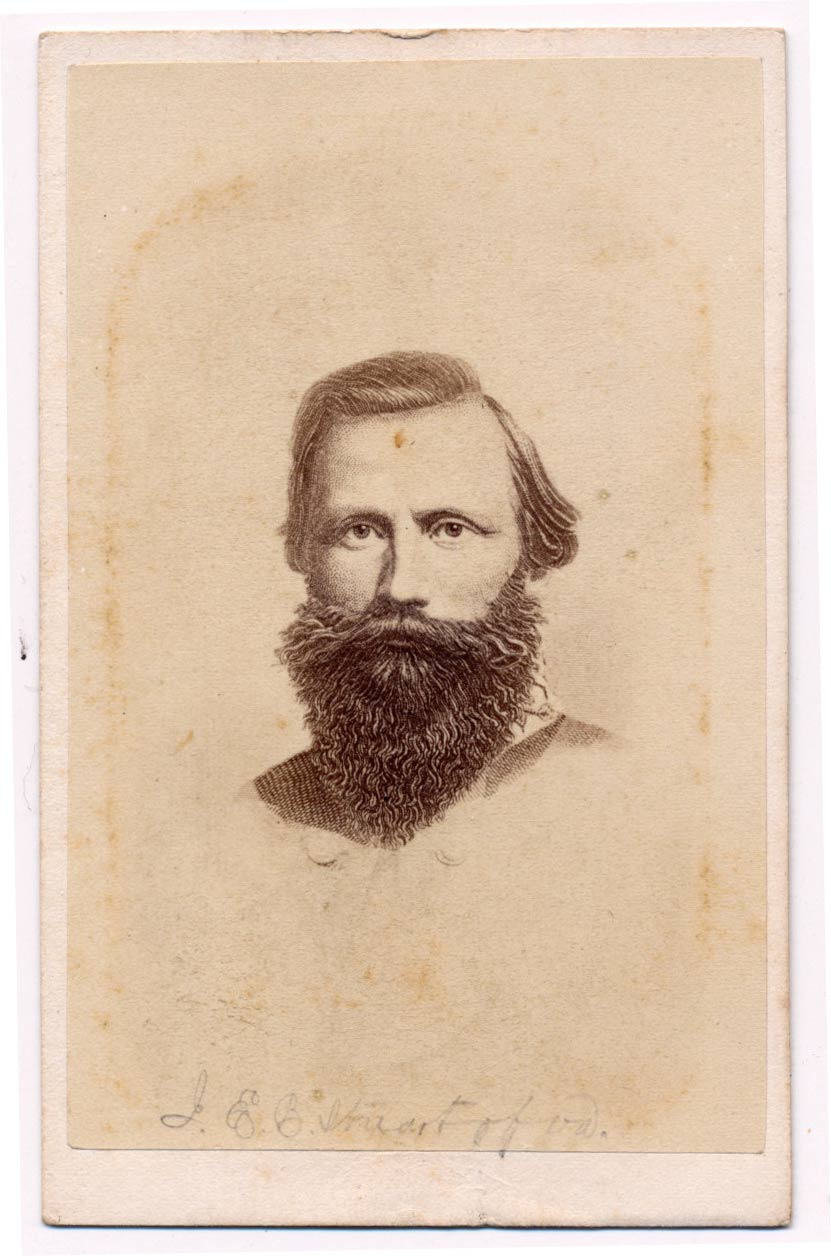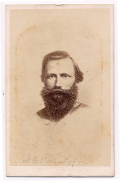site search
online catalog
PERIOD LITHOGRAPH CDV OF JEB STUART

$100.00 SOLD
Quantity Available: None
Item Code: 766-1888
Bust view lithograph of Jeb Stuart.
Contrast and clarity are good. Paper and mount have light scattered surface dirt. Bottom front has a light period pencil ID that reads “J. E. B. STUART OF VA.”
Reverse is blank.
Image is from a Tennessee photo album.
James Ewell Brown Stuart, known as Jeb to his associates, was born February 6, 1833 in Patrick County, Virginia. He attended Emory and Henry College and then West Point, where he graduated 13th of 46 in 1854.
In his U.S. service, Stuart was involved in several Indian conflicts, the “Bleeding Kansas” incident at the Kansas-Missouri border, and then accompanied Colonel Robert E. Lee to crush John Brown’s raid at Harpers Ferry.
Stuart resigned from the United States army in May of 1861 to join the Confederacy and was assigned to General Thomas J. “Stonewall” Jackson, who promoted him to colonel early on and assigned him to command the cavalry of the Army of the Shenandoah. Stuart led his command in the First Battle of Bull Run and in March of 1862, he became commander of the cavalry of the Army of Northern Virginia.
Stuart was a master of reconnaissance missions, and twice made daring exploits, first in the Peninsula Campaign and again at Antietam. He gained promotion to major general after he executed successful raids at Catlett’s Station and Rappahannock River, and then performed in a defensive role at the Battle of Fredericksburg. After the mortal wounding of Jackson during the battle of Chancellorsville, Stuart temporarily assumed command of Jackson's Second Corps and was influential in exploiting the success of his predecessor's famous flank attack.
In spite of Stuart's brilliant reputation (or perhaps because of it), his performance during the Gettysburg Campaign has been the subject much debate and controversy. Prior to 1863 the Federal mounted arm had been repeatedly embarrassed by Stuart. But, in June of 1863 he failed to detect the movements of the Union cavalry that would eventually instigate the largest cavalry battle of the war at Brandy Station, Virginia, in which Stuart prevailed by a narrow margin. Just under a month later, Stuart’s cavalry fell out of touch with headquarters in the days leading up to Gettysburg, and left Lee with little to no intelligence in unfamiliar enemy territory. Stuart finally arrived late on the second day of the battle at Gettysburg and the following day was repulsed by Union cavalry.
Stuart fought his final battle on the outskirts of Richmond on May 11, 1864. The Confederate cavalry was working feverishly to deny Gen. Philip Sheridan's Federal horsemen from gaining entry into the Confederate capital. Stuart's men were able to check the Union advance but at a terrible cost. The Confederate cavalry chief was shot by a dismounted Michigan trooper with a pistol, and the wound proved fatal. He died the day after the battle, May 12, 1864 and was buried at Hollywood Cemetery in Richmond. [ad][ph:L]
~~~~~~~~~~~~~~~~~~~~~~~~~~~~~~~~~~~
THIS ITEM, AS WITH ALL OTHER ITEMS AVAILABLE ON OUR WEB SITE,
MAY BE PURCHASED THROUGH OUR LAYAWAY PROGRAM.
CLICK HERE FOR OUR POLICIES AND TERMS.
THANK YOU!
Inquire About PERIOD LITHOGRAPH CDV OF JEB STUART
For inquiries, please email us at [email protected]
Most Popular
Historical Firearms Stolen From The National Civil War Museum In Harrisburg, Pa »
Theft From Gravesite Of Gen. John Reynolds »
Selection Of Unframed Prints By Don Troiani »
Fine Condition Brass Infantry Bugle Insignia »
British Imported, Confederate Used Bayonet »
Scarce New Model 1865 Sharps Still In Percussion Near Factory New »
featured item
RARE CONFEDERATE “THREE SQUARE” SOCKET BAYONET
This is an excavated example of a Confederate-made musket socket bayonet. Measuring 21” overall with a 2.75” socket. This was made for an early .69 caliber musket with a bayonet lug mounted on the bottom of the barrel; as the bridge is on the… (2022-459). Learn More »
site search
Upcoming Events
May 16 - 18: N-SSA Spring Nationals, Fort Shenandoah, Winchester, VA Learn More »



